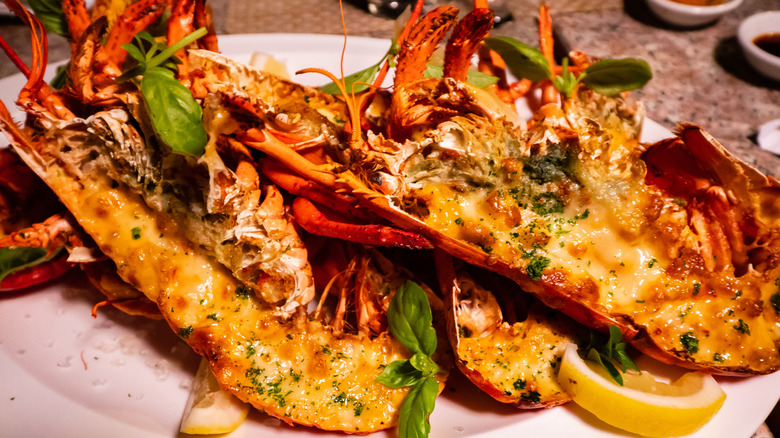The Luxurious Vintage Lobster Dish That Should Be Way More Popular Today
If you're a fan of lobster, you are probably pretty familiar with its many fancy ideations. Beyond the classic steamed lobster with drawn butter, the pricey crustacean also stars as the key ingredient in iconic New England lobster rolls, lobster bisque, and high-end mac and cheese. You'll find lobster fra diavolo in Italian cuisine, and some even put the sweet meat into pot pies. These are just some of the popular ways to treat the hoity-toity shellfish, but one dish that doesn't get the kind of attention it deserves is lobster thermidor.
From the early to the mid-20th century, lobster thermidor was a well-known and desired dish at fine dining restaurants in both France and America. While there was a renewed interest in the dish in the 1970s, its presence has largely diminished on restaurant menus. Made by combining lobster meat with cream, shallots, butter, cognac (The secret to Alton Brown's gravy), and cheese — and serving it all in a lobster shell — it is considered luxe, in both its ingredient list and calorie count. Lobster thermidor is totally over the top; it's expensive to make and requires multiple, time-consuming steps. All of this could be why the dish has all but disappeared, but it's also why it's a worthy splurge.
One might even say that the flavor of the lobster meat gets muddled in lobster thermidor, since it is combined with so many rich ingredients. I speak for myself here, but when those ingredients include cheese and brandy, it might be well worth my time and money to give it a fair chance — or at least put it on my bucket list.
Lobster's rise to fame
Lobster wasn't always the high-end food it is today. Once upon a time in the 1700s, lobster was so plentiful on the New England coastline, that it was used as fertilizer, and it was considered a suitable food source for only prisoners and slaves. In the 1800s, Lobster began forming a fan base amongst a surprising group of people: railway travelers. Railways served lobster to travelers because it was economical, but unsuspecting passengers believed they were dining on a luxurious delicacy. Once word began to spread about this opulent seafood, people started deliberately traveling to New England for a splurge, driving up the high cost of lobster.
It wasn't long before restaurants took notice and started experimenting with the shellfish. Lobster thermidor is believed to have first been created in France in the late 1800s, possibly by one of the country's most famous chefs: Marie-Antoine Carême or Auguste Escoffier who would have served it to elite Parisians. Some believe Napoleon Bonaparte named the dish after the eleventh month of the French republican calendar, "Thermidor," which was an exceptionally hot summer month in France. Others claim that the dish was named for a late 19th century play called "Thermidor" about the French Revolution. Either way, lobster had come a long way by this point, from being nicknamed "poor man's chicken" and "cockroaches of the sea" to gracing the plates of infamous French generals and well-to-do Americans. If nothing else, lobster thermidor certainly gives any diner a literal taste of its fascinating history.

